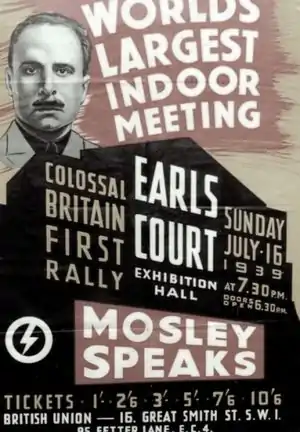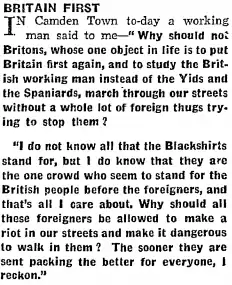Oswald Mosley
Sir Oswald Ernald Mosley, 6th Baronet of Ancoats in the county of Lancashire (1896-1980) was a British aristocrat who fought in World War I and then got himself involved in politics, first for the Conservatives, then for Labour and finally as the leader of various groups of thugs, most notably the British Union of Fascists. The Beeb has declared him the the Worst Briton of the 20th century.[1]
So, how did he show up?
So, he was an aristocrat, descendent of prosperous Anglo-Irish landowners, also having relatives in the British Royal Family.
During World War I, he fought on Ypres (the second battle) and Loos (the only battle).
He married Lady Cynthia Curzon in 1920. She was herself an aristocrat, a daughter of George Curzon who was Viceroy of India and well connected with Tory leaders. He had an idealistic desire to end all wars.
So, in 1918, he was elected for the Conservatives. He was the youngest MP to take his seat, the youngest of them all being abstentionist Sinn Feiner Joseph Sweeney.
From the Conservatives to Labour
In 1919, a conflict started in Ireland: the Irish War of Independence. Winston Churchill, then Secretary of State for War, had an excellent idea: using the Black and Tans, a brutish bunch of thugs who were part of the Royal Irish Constabulary and who terrorized the Irish population (BTW, the Irish still hate these Black and Tans after all these years[2]).
Mosley was not a fan of them either and, so, he crossed the floor, joining the opposition as an independent. He'd win his seat in both the 1922 and 1923 elections as an independent.
In 1924, he joined Labour. He lost the elections that same year, where he ran in another seat, to Neville Chamberlain, returning to parliament in 1926 occupying yet another seat. Meanwhile, he drafted with John Strachey an economic program known as the "Birmingham Proposals," criticizing both classical liberalism and Labourite socialism, in which they proposed an expansion in production through an increase in demand, which would be met by rises in real wage levels, issues of consumer credits to the unemployed and producers' credits to manufacturers, and nationalization of banking.[3]
Being close to Ramsay MacDonald, he made a bid to advance politically. When Labour became the government after the 1929 General Election, Mosley wanted one of the Great Offices of State (Prime Minister, Chancellor of the Exchequer, Home Secretary, or Foreign Secretary). Poor Oswald only could get the office of Chancellor of the Duchy of Lancaster, a Minister without Portfolio outside the cabinet, and he was to draw up a program to combat unemployment.
Out of this came the "Mosley Memorandum," which proposed protectionist high tariffs to protect Britain from international finance, state nationalisation of main industries, and a programme of public works to solve unemployment. It was turned down by the cabinet, after which he resigned from Chancellor, because they were too linked to classical economical thought, and by the Labour Party Conference, after which he got out of Labour.
R. H. S. Crossman, himself a Labourite who did enter the cabinet a couple years later, would later say of the Memorandum as "brilliant" and a "whole generation ahead of Labour thinking."[4] (As evidence of the sometimes strange nature of politics, Crossman was a Zionist and later fought the Nazis in World War II.)
Walking towards fascism

Bitter about this turndown, he founded The New Party, whose corporatist program was supported by dissident Labour and Conservative politicians such as Aneurin Bevan and Harold Macmillan (yes, that Macmillan; we know it doesn't make any sense). The Daily Mail, setting up a... curious track, also supported this party.
However, he ran the party in an authoritarian fashion, so he lost much of his support. It all started when New Party meetings were constantly disrupted, so he created a party militia known as the Biff Boys led by All-England rugby captain Peter Howard.
He then went on a study tour around European fascist movements such as Italy's Fascist Party and Germany's Nazi Party, where he became convinced that Mussolini's way was the way forward for Britain, so he came back and, in 1932, determined to unite the existing British fascist movements, he founded the British Union of Fascists (BUF), which was was protectionist, strongly anti-communist, anti-capitalist, ultranationalistic (practicing an extreme form of British nationalism) and authoritarian-totalitarian. The group's anthem, "Comrades, the Voices of the Dead Battalions", consisted of modified English lyrics from "Horst-Wessel-Lied" (Horst-Wessel Song), the anthem of the Nazi Party of Germany. The group's ideology of what they called British Fascism was largely a mixture of Italian Fascism and German Nazism with local elements added in complete with a paramilitary wing called the Stewards/Blackshirts (the BUF's answer to their spiritual predecessor Italian Blackshirts and the German Nazi Brownshirts/Sturmabteilung) and a flag based off the Nazi Germany template with a reverse color scheme derived from their country's flag using United Kingdom colors like how the Nazis used German Empire colors which was a red background that had the party symbol the Flash and Circle (a white lightning bolt and outline with a blue circle) comparable what the Fasces was to the Italian Fascist Party and the Swastika/Hakenkreuz to the German Nazi Party
At first it did relatively well, it gained the support of the Daily Mail, with its infamous "Hurrah for the Blackshirts!" headline, and the Daily Mirror, as well as 50,000 members at its height. However, the party was involved in violent confrontations with Brirish Communists and Jews and, after their infamous Olympia rally and the Nazi Night of Long Knives, resulted in the loss of BUF support.

Mosley continued to organise marches which worried the government to the point of them passing the Public Order Act 1936[note 1] which, amongst other things, banned political uniforms and quasi-military style organisations and came into effect on 1 January 1937.
As WWII approached, he began an anti-war campaign on the theme of "Mind Britain's Business," which was at first popular enough to regain back support to his BUF. After the invasion of Norway and the start of The Blitz, however, the campaign became highly unpopular to the point of Mosley being wounded in an assault related to his antiwar activities.
Internment and afterwards
In 1940, the BUF was proscibed and Mosley, his now wife Diana and other prominent British fascists were interned under Defence Regulation 18B.
In 1943, with his political reputation discredited, he was freed from internment.
After the war, he founded the Union Movement and the National Party of Europe (NPE), which were focused in his idea of "Europe a Nation" (a pan-European fascist superstate), and opposition to immigration in contrast to the pre-World War II British Union of Fascists which was "Britain First" and Britain in general. In 1961, he participated in a immigration debate at the University College London, with a young David Irving as a supporter. He died from Parkinson's Disease in 1980 while living in France.
Like father, like son (in bed)
Oswald Mosley's son, Max Mosley, is a former Formula One driver and past head of Formula One's governing body, the Fédération Internationale de l'Automobile. In 2008, the British News of the World tabloid released video footage of the 68 year-old Mosley engaging in masochistic role-playing with 5 women dressed in military uniforms. Mosley denied there were any Nazi connotations in the act, and successfully sued News of the World for £60,000.[5] Mosley then sued Google over screen-captures of the video appearing in searches, which he won in France and Germany. Finally, Mosley brought a case against News in the European Court of Human Rights, who ruled against Mosley due to a potential chilling effect on journalism.[6] Mosley's numerous suits likely resulted in a Streisand Effect taking hold, and he was quickly disassociated from Formula One.
See also
- Britain First, the creator of this slogan.
- Enoch Powell, a British politician and ultranationalist who is infamous for his "Rivers of Blood" speech
- Nigel Farage, leader of the UK Independence Party/Brexit Party who is also a British ultranationalist like Mosley
- Christchurch terrorist attacks, the perpetrator of the shooting in Christchurch, New Zealand at Al Noor Mosque and Linwood Islamic Centre Australia-born Brenton Harrison Tarrant was influenced heavily by Oswald Mosley and the British Union of Fascists (BUF).
External links
- See the Wikipedia article on Oswald Mosley.
Notes
- This was in the wake of the 4 October 1936 Battle of Cable Street
File:Wikipedia's W.svg , when 2,000 to 3,000 of Mosley's Blackshirts, outnumbered by about 100,000 counter-protesters (including British who were Communists, Jews, Irish, Socialists, Anarchists, and just about any other group that Mosley either hated or offended), were on the losing side of a number of street fights.
References
- 'Worst' historical Britons list
- See the Wikipedia article on Black and Tans.
- Thomas P. Lineman, British Fascism, 1918-39: Parties, Ideology and Culture (2000)
- Diana Mosley: A Life of Contrasts (1977)
- http://www.theguardian.com/uk/2008/jul/24/mosley.privacy
- http://www.theguardian.com/media/2011/may/10/max-mosley-loses-european-privacy-case